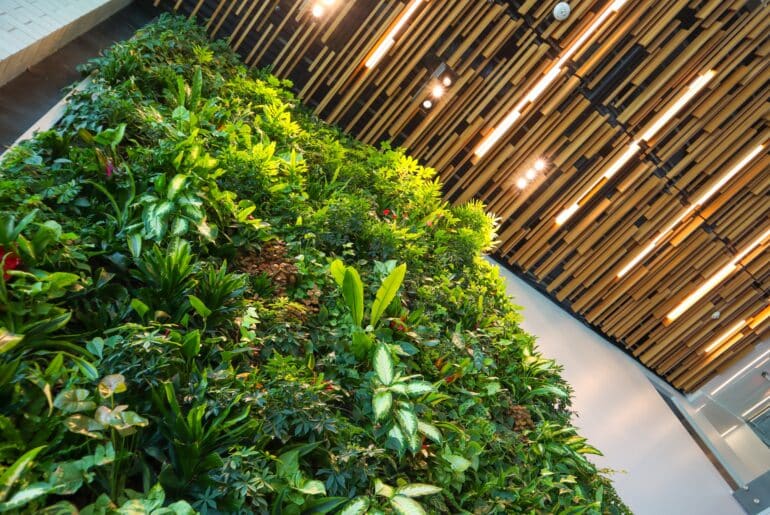Amidst increasingly alarming climate reports and the launch of the World Green Building Council’s Net Zero Carbon Buildings Commitment in 2018, a slew of companies have begun making official commitments to significantly reduce or eliminate their carbon footprint—including tech giants Apple, Facebook, Salesforce, and Lyft—which means real estate teams are diving into Net Zero Carbon strategies. While reducing embodied carbon, implementing energy efficient design, and transitioning to renewable energy are all sound approaches, some are more nuanced to tackle than others.
Natural gas is commonly used for heating and cooking in most buildings. While groups like the Renewable Thermal Collaborative are working to call attention to the issue of natural gas consumption, a full shift away from natural gas isn’t completely realistic right now. Instead, organizations are turning toward carbon offsets as a solution.
Carbon offsets are a climate financing mechanism. Using certificates that represent a reduction of one metric ton of carbon dioxide emissions, people and organizations can purchase offsets that help fund projects that actively offset greenhouse gas emissions. While designing, constructing, and operating spaces to avoid carbon emissions in the first place is best, carbon offsets are another option for reducing one’s carbon footprint when the elimination of fossil fuel-based energy is not viable.
This guide outlines key factors to consider when purchasing carbon offsets so that your organization is contributing to reputable options that are best for the environment. When purchasing carbon offsets, consider these seven criteria in respect to alignment with your project’s and organization’s goals and values.
SEVEN KEY CONSIDERATIONS FOR CARBON OFFSETS
1. Standard
Similar to Green-e certification for renewable energy, Green-e Climate certification is awarded to vetted carbon offset projects to ensure legitimacy and is required for the LEED Green Power and Carbon Offsets credit. Four standards qualify under Green-e Climate—the Gold Standard, the Verified Carbon Standard, the Climate Action Reserve, and the American Carbon Registry—so teams should research their differences to understand the underlying characteristics of their offsets.
2. Project Type
Carbon offsets come in the form of many diverse carbon sequestration and carbon reduction projects at various scales. Some of these include forest preservation, biomass, reforestation, methane capture at landfills, and wind power projects. When determining what projects to support, consider your organization’s key focus and make sure the project type aligns.
3. Volume
The larger the volume of offsets purchased, the more clout buyers will carry in project decisions, such as where the carbon offset project is located and details for project implementation. If it’s possible to scale your project or purchase, buyers will also likely get more favorable pricing for the offsets.
4. Vintage
Carbon offsets can be purchased for projects that are already in operation or are still in planning. Consider if it’s important to your organization that the timeline for the carbon offset project aligns with the timeline for the emissions you’re offsetting. This can also affect pricing.
5. Term
When deciding how long the carbon offsets should last or account for, a common default is the number of years your building or lease will be in operation. A longer term typically yields more favorable pricing. LEED requires a minimum 5-year term for the LEED Green Power and Carbon Offsets credit. Beyond these longer term options, carbon offsets can be made as a one-time expense for actions like employee travel, which is an additional option for organizations making carbon commitments to consider.
6. Location
With carbon offset projects all over the world, it’s possible to choose a local project within a defined number of miles to your organization’s natural gas consumption. Though U.S.-based carbon offset projects can require a slightly larger financial investment, if your company wants to ensure positive local impact or message your carbon neutrality efforts to employees, project teams may want to consider requiring that the carbon offset project is within proximity to your own project site.
7. Seller
Once your team has defined your carbon offset project parameters, it’s time to select a vendor. It’s important to do your due diligence to ensure the provider is legitimate and reputable. Make sure they’re known for past quality projects, and if variety is important to your project team, that they have a strong, diverse portfolio of projects to choose from. Stok has worked with 3Degrees and Schneider Electric in the past, but the right vendor depends on your specific project goals.
While carbon offsets are a nuanced topic, these seven criteria are a solid starting point for choosing the right carbon offsets for your company or project. If you’re not quite (off)set to start purchasing, drop us a line! We’d love to ensure your carbon offset decisions align with your project and organizational goals for greatest positive impact.


